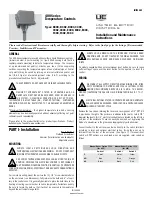
34
Technical Bulletin—TC-9100 Universal Controller
Note: When Programmable Module 1 is configured as Algorithm 3, 4, 5
or 6, the L1A bit of LSC (Item Address 26 hex, Bit 4) indicates
when the module is active, i.e., when heating is active. When
Programmable Module 3 is configured as Algorithm 3, 4, 5 or 6,
the L3A bit of LSC (Address 26 hex, Bit 8) indicates when the
module is active, i.e., when heating is active. Therefore, it is
generally recommended to use programmable modules 1 and 2, or
programmable modules 3 and 4, as heating/cooling controllers.
When a programmable module is configured as one of the Algorithms 7
to 12 (Item PMxTYP, bits 5…1 = 00111 to 01100), the module performs
a calculation function. The calculation module uses up to three input
connections (I1@, I2@ and I3@) to provide the inputs I1, I2 and I3, up to
four constants (K2, K3, K4 and K5), and two “Conditioning Logic
Variables,” which conditionally add two further constants (K6 and K7).
The output is calculated in accordance with the equation for the
algorithm, as follows:
Algorithm 7: Average
Output (OCM) = [(I1
×
K3 + I2
×
K4 + I3
×
K5) / K2 + A]
×
B
(If an input is not connected, the corresponding value
In
will assume a
default value of 1.)
Algorithm 8: Minimum
Output (OCM) = [K2 + MIN(I1
×
K3, I2
×
K4, I3
×
K5) + A]
×
B
(If an input is not connected, the corresponding value
In
will be excluded
from the calculation.)
Algorithm 9: Maximum
Output (OCM) = [K2 + MAX(I1
×
K3, I2
×
K4, I3
×
K5) + A]
×
B
(If an input is not connected, the corresponding value
In
will be excluded
from the calculation.)
Algorithm 10: Equation 1
Output (OCM) = K2
I1 K3 + I2 K4
I3 + K5
A
B
+
×
×
+
⎡
⎣⎢
⎤
⎦⎥
×
(If an input is not connected, the corresponding value
In
will assume a
default value of 1.)
Algorithm 11: Equation 2
Output (OCM) =
(
) (
)
K2
I1+ K3
I2 + K4
I3 + K5
A
B
+
×
+
⎡
⎣⎢
⎤
⎦⎥
×
(If an input is not connected, the corresponding value
In
will assume a
default value of 1.)
Algorithms
7 to 12:
Calculation
Modules
















































